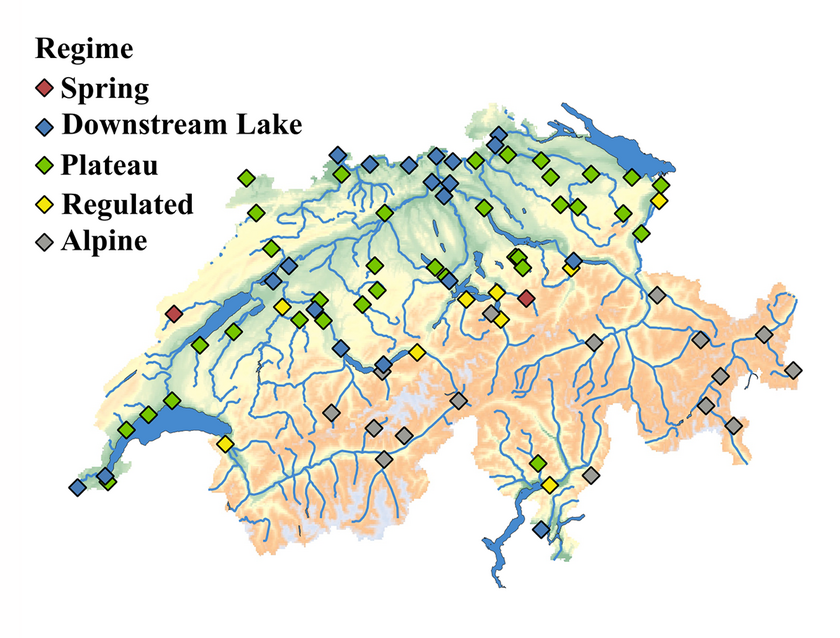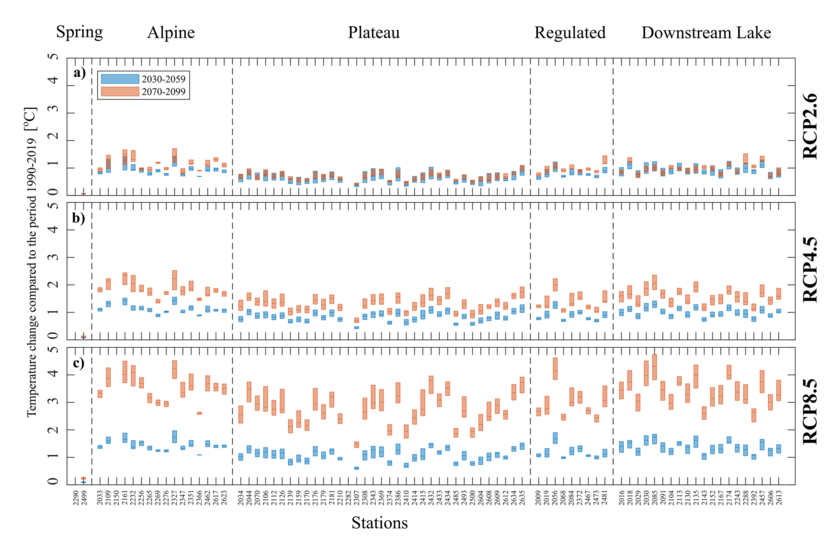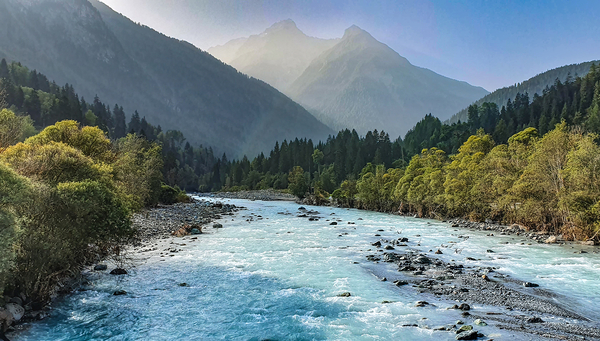News Detail
How much Swiss watercourses will warm up
July 15, 2025 |
Climate change is already clearly noticeable in Swiss waters. Water temperatures have risen continuously in recent decades and runoff volumes have also changed. This is not only a problem for heat-sensitive aquatic organisms, but also for the use of rivers by us humans, such as for cooling. In a research project funded by the Federal Office for the Environment (FOEN), researchers from the aquatic research institute Eawag and the University of Basel have investigated what we can expect in the future and which Swiss rivers will be particularly affected by warming.
To model future water temperatures, they used data from the 82 runoff monitoring stations operated by the FOEN. They categorised these stations into five different types (see diagram), where different factors are decisive for water temperature in each case. In alpine waters, for example, runoff volume and temperature are strongly influenced by the melting of snow and glaciers. In rivers fed by springs, i.e. groundwater, the water temperature is almost constant because the groundwater buffers fluctuations in air temperature. The future development of each of these types of watercourse could thus be modelled individually.

In addition to the data from the runoff monitoring stations, modelling was based on forecasts of the near-surface air temperature and runoff volumes – in each case for three different scenarios for the further progression of climate change: one scenario with climate protection action, one with limited action and one without any climate protection measures at all. For each scenario, the temperature rise in water bodies in the near future (2030 to 2059) and in the distant future (2070 to 2099) was modelled and compared to the reference period (1990 to 2019).
The results were published in the journal Aqua & Gas and as a preprint for the scientific publication (see below). As expected, they show that the less climate protection action is taken, the more river temperatures will rise. However, the trend is not continuous. While warming accelerates over time in the scenario without any climate protection, it reaches a plateau in the middle of this century in the scenario with climate protection measures.

Rivers influenced by groundwater hardly warm up at all
Moreover, the extent of water warming differs depending on the type of water body. It is most pronounced in alpine waters, which will warm by 3.5°C by the end of the century without climate protection measures. This is related to the rise in air temperatures, which is also strongest in these regions. The warming in rivers below lakes will be almost as strong: in extreme cases, it will be +3.4°C there. Because the water stays in the lakes longer, it can warm up more – which is noticeable in the rivers downstream of lakes. At measuring stations below springs, where the water is heavily influenced by groundwater, on the other hand, the temperature hardly changes – only by +0.05°C in the near future and +0.1°C in the distant future.
In addition to the development of mean water temperatures, the researchers also investigated the change in runoff volumes and extreme water temperatures in the summer months. According to their analyses, runoff volumes will decrease by 10 to 40% in summer, which will exacerbate the seasonal warming of rivers and lead to long dry periods. On the other hand, runoff will increase by 10 to 30% in winter. Extreme temperature events will increase the most in rivers downstream of reservoirs by the end of the century, followed by rivers on the Central Plateau.
Basis for planning adaptation strategies
Knowing where and how temperatures in watercourses will change can help when planning targeted measures, for example to protect heat-sensitive aquatic organisms such as brown trout. Such measures can include adding shade to the banks, adapted reservoir management or the renaturalisation of rivers. The researchers also suggest making greater use of groundwater to regulate the temperature. By infiltrating river water into the groundwater in winter and, conversely, feeding groundwater into the rivers in summer, the runoff may also be increased during dry periods in summer. Sustainable groundwater management is therefore an essential component of climate adaptation strategies.
Cover picture: The new findings on the future warming of watercourses will help to plan adaptation measures in a more targeted manner (Photo: Adobe Stock).
Original publications
Vinnå, L. R.; Bigler, V.; Schilling, O. S.; Epting, J. (2025): Multi-fidelity model assessment of climate change impacts on river water temperatures, thermal extremes and potential effects on brown trout in Switzerland. EGUsphere, https://doi.org/10.5194/egusphere-2024-3957
Funding / Partnerships
- FOEN
- Eawag
- University of Basel
- Bern University of Applied Sciences for Engineering and Information Technology

